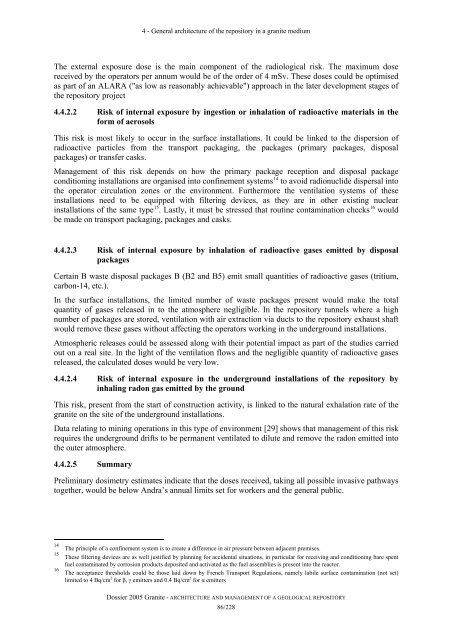Tome Architecture and management of a geological repository - Andra
Tome Architecture and management of a geological repository - Andra
Tome Architecture and management of a geological repository - Andra
You also want an ePaper? Increase the reach of your titles
YUMPU automatically turns print PDFs into web optimized ePapers that Google loves.
4 - General architecture <strong>of</strong> the <strong>repository</strong> in a granite mediumThe external exposure dose is the main component <strong>of</strong> the radiological risk. The maximum dosereceived by the operators per annum would be <strong>of</strong> the order <strong>of</strong> 4 mSv. These doses could be optimisedas part <strong>of</strong> an ALARA ("as low as reasonably achievable") approach in the later development stages <strong>of</strong>the <strong>repository</strong> project4.4.2.2 Risk <strong>of</strong> internal exposure by ingestion or inhalation <strong>of</strong> radioactive materials in theform <strong>of</strong> aerosolsThis risk is most likely to occur in the surface installations. It could be linked to the dispersion <strong>of</strong>radioactive particles from the transport packaging, the packages (primary packages, disposalpackages) or transfer casks.Management <strong>of</strong> this risk depends on how the primary package reception <strong>and</strong> disposal packageconditioning installations are organised into confinement systems 14 to avoid radionuclide dispersal intothe operator circulation zones or the environment. Furthermore the ventilation systems <strong>of</strong> theseinstallations need to be equipped with filtering devices, as they are in other existing nuclearinstallations <strong>of</strong> the same type 15 . Lastly, it must be stressed that routine contamination checks 16 wouldbe made on transport packaging, packages <strong>and</strong> casks.4.4.2.3 Risk <strong>of</strong> internal exposure by inhalation <strong>of</strong> radioactive gases emitted by disposalpackagesCertain B waste disposal packages B (B2 <strong>and</strong> B5) emit small quantities <strong>of</strong> radioactive gases (tritium,carbon-14, etc.).In the surface installations, the limited number <strong>of</strong> waste packages present would make the totalquantity <strong>of</strong> gases released in to the atmosphere negligible. In the <strong>repository</strong> tunnels where a highnumber <strong>of</strong> packages are stored, ventilation with air extraction via ducts to the <strong>repository</strong> exhaust shaftwould remove these gases without affecting the operators working in the underground installations.Atmospheric releases could be assessed along with their potential impact as part <strong>of</strong> the studies carriedout on a real site. In the light <strong>of</strong> the ventilation flows <strong>and</strong> the negligible quantity <strong>of</strong> radioactive gasesreleased, the calculated doses would be very low.4.4.2.4 Risk <strong>of</strong> internal exposure in the underground installations <strong>of</strong> the <strong>repository</strong> byinhaling radon gas emitted by the groundThis risk, present from the start <strong>of</strong> construction activity, is linked to the natural exhalation rate <strong>of</strong> thegranite on the site <strong>of</strong> the underground installations.Data relating to mining operations in this type <strong>of</strong> environment [29] shows that <strong>management</strong> <strong>of</strong> this riskrequires the underground drifts to be permanent ventilated to dilute <strong>and</strong> remove the radon emitted intothe outer atmosphere.4.4.2.5 SummaryPreliminary dosimetry estimates indicate that the doses received, taking all possible invasive pathwaystogether, would be below <strong>Andra</strong>’s annual limits set for workers <strong>and</strong> the general public.141516The principle <strong>of</strong> a confinement system is to create a difference in air pressure between adjacent premises.These filtering devices are as well justified by planning for accidental situations, in particular for receiving <strong>and</strong> conditioning bare spentfuel contaminated by corrosion products deposited <strong>and</strong> activated as the fuel assemblies is present into the reactor.The acceptance thresholds could be those laid down by French Transport Regulations, namely labile surface contamination (not set)limited to 4 Bq/cm 2 for β, γ emitters <strong>and</strong> 0.4 Bq/cm 2 for α emittersDossier 2005 Granite - ARCHITECTURE AND MANAGEMENT OF A GEOLOGICAL REPOSITORY86/228
















